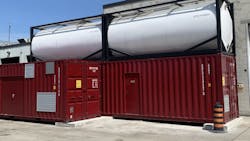Trimac sets cleaning precedent with Canada’s first Gröninger system
Trimac recently installed what it says is the first tank wash featuring Gröninger Cleaning Systems’ transformative technology in Canada.
Already widespread internationally, the Rotterdam, Netherlands-based supplier’s high-pressure, low-volume automated systems boast faster, more consistent cleans, and are expected to deliver major improvements to Trimac’s National Tank Services offering.
The first wash using the system is expected to take place in late June or early July, Trimac said.
“This is like moving from a garden hose to a pressure washer,” said Marc Gravel, director of facilities and real estate, who helped with the pilot project’s management and business case. “This high-pressure, low-volume system offers us more targeted cleaning, reduces cycle time, and improves efficiencies.”
Installation of the cleaning system now is underway at the Mississauga, Ontario NTS facility as a pilot project. The high-tech system boasts it can clean tanks more thoroughly, consistently, and efficiently than conventional cleaning systems, while also saving users money and taking half the time of a standard clean.
The pilot project in Mississauga will put the system to the test and determine if the investment is worthwhile to span to other NTS locations across North America, Trimac said. It the project is successful, the NTS team will begin evaluating the system’s use at two other cleaning locations where the technology could be beneficial.
The proprietary tech involves plunger pumps and electric motors with variable frequency drives (VFDs) to enable premium Gröninger spinners to achieve multiple cleaning pressures, which, depending on the size of the pump, range from 40 pounds per square inch (psi) all the way up to 18,000 psi—an ultra-high pressure rarely required by the average tank wash, outside of cleaning isocyanides that must be hydro-blasted off a surface.
Programmable logic controllers (PLCs), which are industrialized digital computers, tie the system together, making it user-friendly and ensuring consistent cleans by operators in multiple locations. Utilizing telemetry from equipment sensors, the PLC automates wash processes and monitors critical inputs, like temperature, pressure, and flow. Readings are collected in the system’s “brain,” converted into relevant data, and outputted as visual cues on a digital touchscreen that displays any errors or product shortages—and gives operators the best chance of doing their job correctly.
“I’ve been in the industry 27 years and this will completely convert the amount of water and pressure we used in the conventional wash process from 100 gal/min of water, with 250-300 psi pressure, to this new system of 26-52 gal/min of water 1,700-2,200 psi pressure,” said Trevor Tiffany, director of business development, who has been working on getting the system implemented at Trimac since 2016. “This has the potential to increase our capacity and our ability to wash tanks faster.”
For a typical 40-foot trailer, a 90-minute wash time can be done as quickly as 20 to 45 minutes, according to Gröninger.
The company’s wash systems also feature high-volume blowers with steam heat exchangers that enable them to produce ambient or heated air. As with switching a hairdryer from cool to hot, warmer air dries tanks faster. Larger motors also allow operators to control up to six blowers with one motor, with airflow regulated by PLC-controlled valves, ensuring air only is flowing where it’s needed. A more thorough wash reduces the need to enter the tank for final cleanup, promoting safety.
This system is better for the environment because it uses less water than traditional cleaning systems. It runs for a third of the time, using significantly less water in the process, and saves energy costs.
Trimac isn’t the only tank wash company to see the potential of this system. Approximately more than 300 Gröninger systems are now working across five continents.
“We are looking forward and investing in technology with Trimac’s new five-year strategy,” Gravel said. “We can now do more with less, washing more equipment with the same bays and number of people. This project is one of largest investments in technology we have done so far as part of Project Polaris and Trimac’s strategic transformation. We are investing in technology and the future of the NTS business.”
